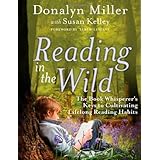This week's reflection in on chapter 5 and the Appendices of Reading in the Wild: The Book Whisperer's Keys to Cultivating Lifelong Reading Habits by Donalyn Miller.
Wild Readers Show
Preferences
Assisting my
students to become independent readers is one of my responsibilities as a teacher. I want to support them as they grow into wild
readers. Like adults, our students are
readers who have different personalities and experiences. As we find out as much as we can about our
students, we become better equipped to support them as readers.
Helping to connect
students to books is one of the ways that we can offer students support. Three areas stood out for me in Reading in the Wild as ways for readers
to “connect” to books. They connect with
books by being introduced to read-alike titles, by allowing them to include
light reading as an option for book selection, and by providing them
opportunities to reread favorite books.
Read-Alike Titles
I love the
idea of read-alike titles. As an adult reader, I often gravitate to the
kinds of books I’ve enjoyed reading in the past. Why should that be any different for my first
grade readers? Once I identify what my
first graders enjoy reading, I can use their interests to suggest similar types
of books for their independent reading time.
I’m also aware of the kinds of books my students tend to enjoy as a read
aloud and I’m constantly on the look-out for those kinds of books. Books that provide weird, gross, or
interesting facts, books that make you laugh, and books that teach powerful
lessons. I’ve never referred to these as
read-alike books before but I think this is my new, favorite title for
identifying these books.
Light Reading
When my
first grade readers choose books for their reading baskets I ask them to select
6-8 good fit books, 2 informational books, and 2 free choice or look-books. Inevitably, I have some kids who choose books
that are below their reading level as their free choice option. Donalyn shares evidence that this type of
reading helps readers become more competent and it motivates them to read more. Who doesn’t enjoy a light read from time to
time? I think most wild readers do.
Rereading Favorite
Books
In primary
classrooms students enjoy rereading their favorite books. On book shopping day I usually have 2 or 3
students who ask if they can keep one or two of the books in their baskets so
they can reread them. As I was reading the story Donalyn shared
about her student, Jordan, who reread the Harry Potter series and shared how he
“discovers new things” when he revisits books, it reminded me of my favorite
movies. In addition to loving books, I also
enjoy watching movies. Sometimes I watch
my favorite movies over again. I often
discover new things in the movie upon the second or third viewing. I often share this analogy with my students
as well. When I’m sharing a read aloud
that my students have read before I explain that it’s like the movies I’ve seen
again and again. Perhaps they’ll
discover something they didn’t notice before.
I also remind them that they are not the same readers they were last
year when they were introduced to the book the first time. There are a lot of benefits to rereading
books. “In fact, rereading books
increases comprehension and enjoyment.” (p. 175) I totally agree with Donalyn
when she says, “f they reread books because they love them, I say let
them. We want to develop students’
ownership of reading. When we tell
students they can’t reread a book they love, we put our goals in front of
theirs.” (p. 176)
Nonfiction Reading
I was shocked
to read that older students avoid and dislike reading nonfiction books. I have to agree with Donalyn when she says
that it’s probably because they lack positive reading experiences. My first grade students love reading nonfiction
texts. I’m sure it has a lot to do with
their curious nature. First graders are
like sponges and they soak up tons of information while listening to and reading
nonfiction texts. Over the last few
years I’ve made an effort to share more nonfiction texts when I read aloud to
my students. On page 180 Donalyn shared
this list of really good activities for using nonfiction text in the classroom:
·
Add
more nonfiction book talks.
·
Read-aloud
nonfiction texts.
·
Use
nonfiction as mentor texts.
·
Pair
fiction texts with nonfiction on related topics.
·
Provide
students frequent opportunities to preview, read, and show nonfiction.
Appendices
There are a
ton of great forms in the Appendices for use in supporting students as they
become wild readers. My goal is to
revamp some of them in order to make them more primary-friendly. I’m hoping that other primary teachers are
planning to do the same thing. Perhaps
at some point we can share the forms we create.
I love the idea of using “reader” in place of “name” on these
forms. That was a great idea and one
that I plan to use in other areas.What are your thoughts? Thank you for taking the time to read and add your voice to the conversation.

